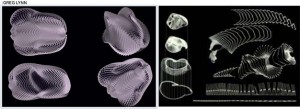Image reference: http://digilander.libero.it/LauraCamilla/F2.cap1c.htm
Manuel De Landa’s ‘Deleuze and the genesis of form’ speaks about the philosopher’s concepts and ideologies that defined the evolution of a particle to the shape it would subsequently attain. According to him, form is the subsequent result of the various forces of nature acting outside or within the base particle and not something that has been predefined by a superior power. For instance, ‘the spherical form of the soap bubble emerges out of the interactions among its constituent molecules’. In an architectural perspective, I believe the writer implies that the form of a building must evolve as a result of various factors, be it climatic, topography, human behaviour etc. One underlying theory that the text is based on is that structures can be defined under two broad categories of Strata and self-consistent aggregates. Strata being a homogeneous entity where the constituent elements are similar to each other in form or chemical composition. Self-consistent aggregates comprises of a mix of heterogeneous entities. In an architectural sense, a strata can be defined as a carefully planned city with various overlapping layers where each layer is dependent on the other and a self-consistent aggregate could be slums which are comprised of heterogeneous entities where one can co-exist without the other.
The Rolex Learning Centre, Designed by SAANA, at Lausanne, is a fluid structure aimed at being an architectural landscape rather than a building bound by walls and floor slabs. The building is set in a comparatively flat area and stands out as the only undulating surface on the site. This shows a clear topographical transformation that the architect has tried to achieve. The structural correspondence with the highly complex floor slabs placed on a simple 9×9 grid is very interesting.
The Rolex learning centre throws light on the various concepts of Deleuze s mentioned in De Landa’s text. The design of the building is a result of the human behaviour. Human movement, which the architect says is never linear is the basis on which the fluid form of the building and its long circulation spaces were derived from. I believe this case study is an example of both strata and self-consistent aggregates because in structure, it is meticulous in terms of the positioning of the curved slabs over a rigid grid, the layering of open patios and integrating it with the design to promote human. There is a co-relation with each of the layers and one does not validate itself without the existence of the other. The spaces are not clear cut and predefined by the architect but by the users. Which makes every space flexible and subject to variation. Much similar to the rhizome, which is a constantly evolving system that is not constrained by boundaries.
‘Architectural Machines’ have played an important role in the design of the building enabling the architect to envision the structural parameters of the building in terms of the deflection of the concrete slabs and achieving the optimum ventilating and heating systems for the building.
Architecture which is less rigid and more fluid and responsive to the environment. One which is a result of the various forces of nature and one which is constantly changing and evolving much like the rhizome. How do various forces, be it man made or natural influence design and at what level. How feasible and ideal is such a concept at a practical level. Up until now, growing and changing to me, were not words I would relate to a building. In my research I would like to see to what extent that can impact my design and my view on architecture. I would also like to study the rhizome philosophy further and see how closely related it is to the said context.

